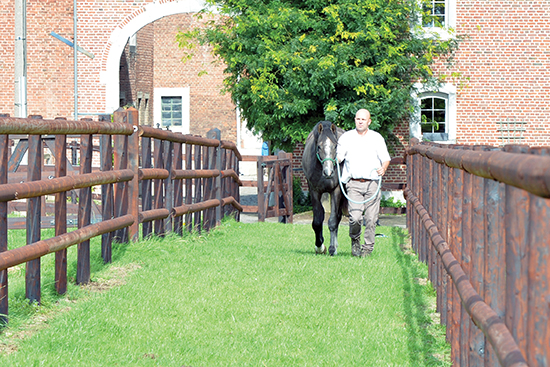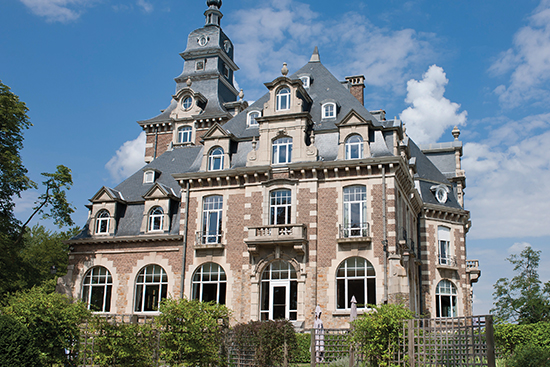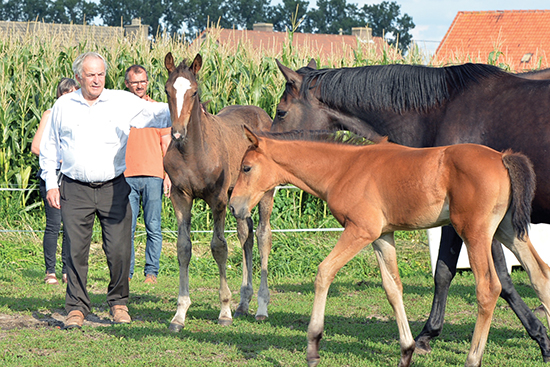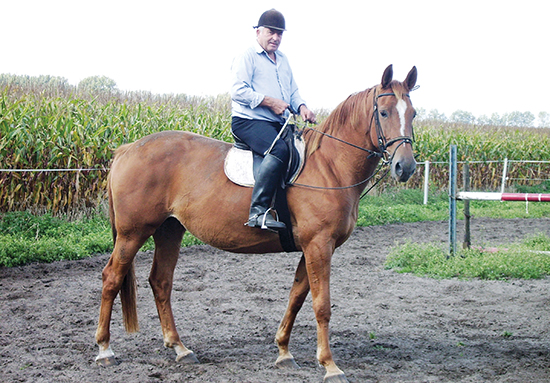One of the new breeders, Michel Rigo
One of the traditionalists, Willy Taets
Story by Christopher Hector and Photos by Roz Neave and archives
It is really nice when a breed society welcomes you with open arms – and that is exactly what happened with the Belgian studbook, sBs.
Their media person, Catherine Aerts set the process in train, arranging up our visit to the capital of French speaking Belgium, Namur, which is also home to the sBs – where we were their guests at the Chateau de Namur, a very pleasant hotel just out of the main town. When Catherine fell sick, the administrative expert, Michèle Delaurier took over care of the visiting Aussies, and it was sBs General Secretary, Marc Pierson, who welcomed us with a wonderful meal in a bistro that might well have been in the centre of Paris.
Marc is a medical doctor, a general practitioner who retired last year, and his interest in riding brought him to the studbook: “I was just a rider at a small level and a friend of mine, an old man, told me there was a place for me in the administration of the studbook, ‘it is a little job, they have a meeting every month and it is not a big task for you…’ That was the beginning in 1991, twenty five years ago.”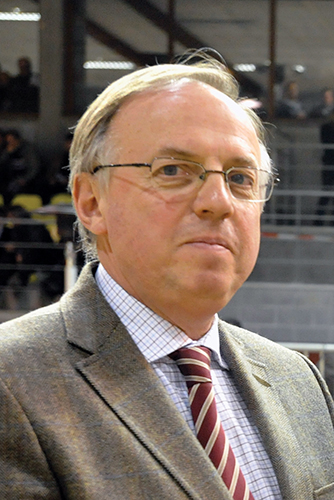
Even now he is General Secretary, the sBs involvement is not full-time: “It is a job that takes a lot of the day, but it is not my main job.”
“My grand-father worked with heavy horses, and my father loved horses also. It was quite easy for me to ask when I was nine years old to receive a pony – two ponies in fact. When you begin with ponies you go on to horses…”
“I was an amateur rider, no more.”
For such a small country, Belgium is wildly complex, it took 589 days to even form a government, so I guess we shouldn’t be surprised that it is home to three different studbooks: BWP, in the north, sBs in the south, and Zangersheide which has its home at Lanaken in the east.
“In Belgium we have a specific political, economic, sociological situation. In the beginning in Flanders, they had heavy horses and they decided to produce a sport horse by crossing with the Thoroughbred and Anglo Arabs, and some Selle Français. The people in Flanders then went to The Netherlands and to Germany.”
“In the south, in Wallonia, we decided to go to France to find stallions to cross with the mares we have. In Wallonia it was not so much heavy horses, we also bred horses for the Army, and that is the real beginning of the sBs, the cheval d’armes. After WW2, they needed to produce a sport horse, so they went to France to choose the stallions.”
“We preferred to go to France because it was the same language and the same culture. But we have a very liberal breeding system, so breeders can choose where they want to go.”
“That is one of the keys of the success of the Belgian breed, the outcrossing with France, Germany, Netherlands, with the heavy mares we had, mares that had a big heart for work. It is an interesting quality, from the mares, our horses have a big heart, they want to do the job, and with the sports stallions from abroad, in twenty years this mixture was a big success.”
Private stallion owners?
“All the system is private in Belgium. We have no national stud, no national organization. We have about 300 stallions in Belgium for the three studbooks, in sBs, we have about 150 stallions, it’s too many. It would be better to have fewer stallions, it is easier then to make a selection.”
Belgium was the first breeding area to recognize that health considerations were of prime importance in producing sporthorses:
“Since 25 years ago, they need to be checked by the vet – we were the first studbook in Belgium to impose the vet check for stallions – that’s the first condition on the way to approval for a stallion. We have two veterinary schools in Belgium, and the vets discuss what is good, and what is not good, and their assessment is used by all three Belgian studbooks – sBs, BWP and Zangersheide.
Is it still the small breeder with just a couple of mares who is the backbone of your studbook?
“For us, yes. We have some bigger studs, when I say bigger, that is about ten mares, not more. In Wallonia we have maybe ten studs with ten mares or more – in Flanders it is a bit more.”
Is it frustrating to you that if we added sBs to BWP and Zangersheide, this would be the most successful studbook in the world?
“When you look from outside Belgium, it could be an interesting solution, but we have three Federal regions, Flanders, Wallonia and Brussels, in Belgium. In each of those regions, the rules for breeding, and the administration, is very different. There is no breeding in Brussels, but in Wallonia, we have a close contact with our agricultural ministry and it is quite difficult to say to the ministry, you pay the money to help the breeders, and this money will go to Flanders. And the reverse is also true. But from abroad, sure it looks a good solution. We tried it in the past, with Z, but Z is a private situation, whereas we are an association and all the members have the same rights. It collapsed because it was not possible to discuss with Z, they had their own way of doing things, an agreement was not possible. Recently, Z tried to come together with the BWP but it was not possible. It is Mr Melchior’s own money, he does what he wants to do.”
How do you see the future for the sBs?
“The worst months are behind us. In Europe there is an economic crisis, and the horse business doesn’t escape that crisis. But now we have a stabilization of the number of foals, but as you know when you breed a horse, it takes time to come onto the market. What we have now is a lot of five and six-year-old horses coming onto the market, but comparing that with the number of foals born in 2015, it is about 60 or 70% of the number of foals being born five years ago. I don’t know the future, but I think we have gone to quality in place of quantity, that’s what we see.”
In Germany they talk a lot about the disappearance of the old traditional breeders and the coming into the horse world of the new breeders – is that happening in the sBs?
“That is also my worry. I would like to see more young breeders coming into the industry, but it is difficult. There is a lack of money, and when you want to go into breeding you need to invest in good mare lines – you don’t need a lot of mares if you have good mares. Belgium is a very small country and it is quite difficult to find space to breed horses. It is particularly a problem in Flanders where they have very little space. Right now there are too many horses for sale, and only the very good ones will find a buyer, a lot of foals are sold for very little.”
Does it help when you have a star horse like Sanctos to put you on the map?
“For us it is fantastic, when you have at the same time five or six really good horses, star horses competing in five-star Grand Prix with the best riders of the world – like Scott Brash, like Kevin Staut, like Penelope Leprevost, like Lucy Davis in the States – it is a really good situation for us.”
“My wife likes to go to the very big international shows, me, I am happy to just spend the day at the smaller shows, watching the amateurs, talking to the breeders… that is what makes me happy.”
Marc and Michelle had arranged for us to picturesque Waremme in the north of the province of Liège, where we found Ann-Valerie and Michel Rigo. They live in a huge old farmhouse that not only houses their horses but also Michel’s monstrous agricultural machines. These are not traditional breeders, they are the new wave in the sBs but so far, they have been hugely successful.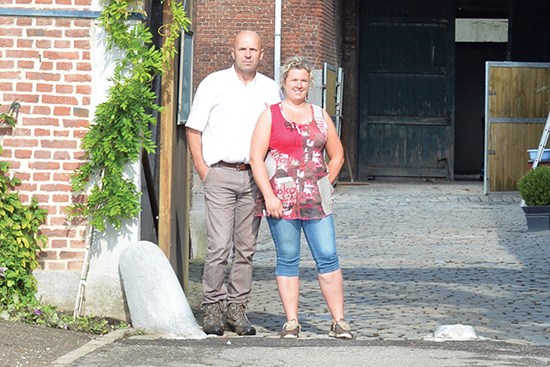
Ann-Valerie and Michel Rigo
One of their first horses, Gangster won the 6 year old World Young Horse Championship at Lanaken in 2012, and he is now at the Steffex stables where he is being campaigned with great success by Lorenzo de Luca, placing in top shows, including a 4th in a 1.50 class at Rome 5 star.
“He was my favorite one, I cried a lot when he left,” says Ann-Valerie.
Gangster de Longchamps is by the Heartbreaker son, Orlando and out of Tosca der Poel by the Grand Veneur son, Sheyenne de Baugy out of a mare by one of the foundation sires of Belgian breeding, the Ibrahim son, Fantastique.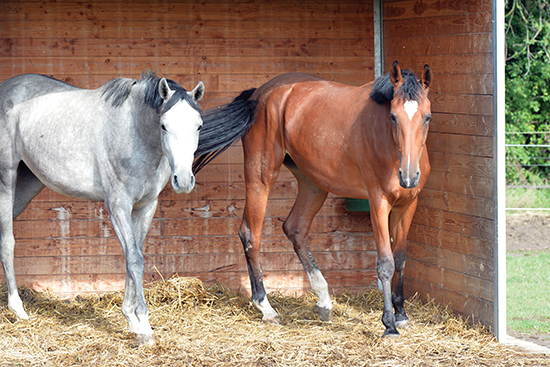
“We bought the mare ten years ago, and Gangster was our first foal from this mare.”
Tosca was sold to a friend, but the Rigos bought a filly from Tosca’s full sister, by Inschallah de Muze, and when they went to pick up their foal, “we fell in love with another one, so we bought two foals,” the other by Verdi. “We left them there for three months and last week we went to visit our foals, and we fell in love with another one, a Zirocco Blue out of a Chin Chin mare – another filly.”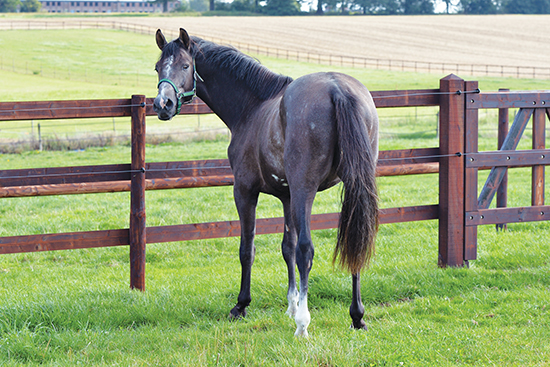
This is Michel and Ann-Valerie’s colt by Russel out of a Goodtimes mare – already a free jumping winner
Ann-Valerie and Michel came together because of horses: “We met because of our interest in breeding. I had my first mare, my only horse then, by Bon Ami, in 1991, and she died of colic but I had the rights to a covering. I knew of Mr Rigo, and I said to him, you breed with this same stallion, do you want to buy my service? He bought my cover, and we stay together.”
Michel had started breeding, but like Ann-Valerie only with one mare, Ann-Valerie was to add to the mare band:
“When I lost my good mare by Bon Ami, I bought a six month old filly by Bon Ami, Penelope, and she came here with me and when she grew up, we started to breed with her. Tosca was the next, and then again and again. We have had a lot of luck because we have good horses with not many mares. We only have two or three foals a year but they are always good horses.”
Is the aim to breed horses to sell, or to breed horses to compete…
“We work with Stephex Stables because it is easier for us. We keep the horses until they are three or four years old, then send them there. Here we have no rider, it is not easy for us – when we had Gangster we had to take him to the trainer and pay the trainer. Now it is a business for us, before it was only our passion.”
How do you select your stallions?
“We watch the competitions and the results. We work a lot with Toulon, Clinton, Heartbreaker – once you have Heartbreaker in your pedigrees then I think you always have a good one.”
In Belgium, you can take your pick of three studbooks – why did you choose sBs?
“We tried the other ones. In Belgium there are Flemish and there are French people, when we go to the Flemish shows, we are not welcome. For us it is so much easier with sBs, we all know each other. You are like a stranger in the other studbooks.”
What is the next step for you, are you going to get bigger?
“No, no, no, when you have too many horses you cannot do things well, you just don’t have time. Here we have three foals that is enough.”
It is not all horses at de Longchamps, Michel has two farms, 200 hectares of fields. Sugar beet, wheat, potatoes, peas, flax, and tractors, big, big tractors. For Ann-Valerie, it is a good balance:
“With the horses, and the farm and the children, it is a lot of work, but that is what we like, and it is not work if you like it. At the weekends my daughter rides in the shows, or I show my foals, that’s our life.”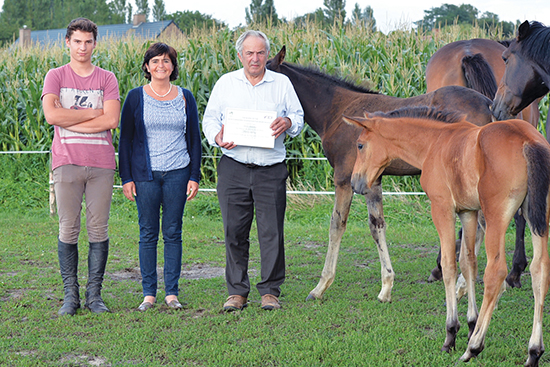
Willy Taets, daughter Lieve and grandson, Joachim
It is a long long drive to Lembeke, home of the Taets family, but a drive well worth it since this is the home of the most famous sBs product of them all, Hello Sanctos. This is truly a family stud in the old style, with the founding father, Willy Taets, his daughter, Lieve and her husband, Marc, and their son, Joachim Buyck. As we drive up, Joachim is schooling his horse in the paddock, but he soon comes to join us for a round table family conference.
Willy Taets was named WBFSH Breeder of the Year in 2014 and took his first ever aeroplane ride to receive his award, “It was an experience for my father, first time in a plane to Geneva, it was something special,” says his daughter, Lieve.
How did this family of horse breeders start?
“My father is a farmer, they had some milking cows, a small farm. He was also a horse rider. A very long time ago he bought a mare, a Lipizzaner and she had a foal – that was the start of the breeding here. The foal became my brother’s horse. That was the beginning, we then had a lot of foals. My father bought another horse to ride – Balin – and that was the grand-mother of Sanctos.”
Balin was by the Selle Français stallion, Fier de Lui (by Rantzau xx) and out of the Belgian mare, Nalinne, who was by another French stallion, L’Ormel (by Harphortas xx) out of the Gelderlander mare Dorina.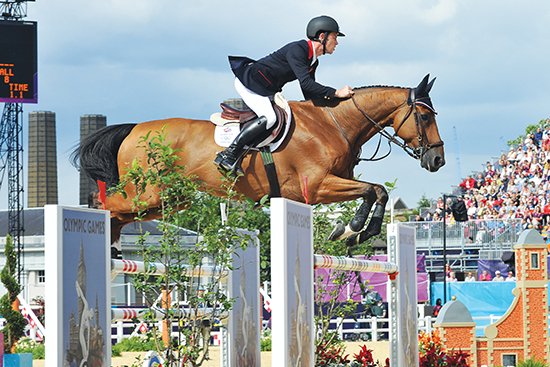
Hello Sanctos and Scott Brash at the London Games
Bred to Nabab de Rêve, Balin produced Nasia van het Gravenhof, the dam of Sanctos.
According to Lieve, the stud just kept growing and growing…
“Every year my father had more foals and he sold some – but the nicest mares, he kept. It started with one horse, then at one time there were twenty horses here, a little bit too much.”
What were the most important stallions your father used?
“His favorites were the French ones. He always tried to use the young stallions, he was not afraid to take a risk, he said – give me the young ones and maybe they will turn out good. He used a lot of Nabab de Rêve in his younger years.”
Lieve’s son, Joachim has obviously caught the breeder bug, and studied his grand-father’s program:
“My grand-father always picked the young ones because you did not have to pay so much, and it was a hobby for him. For example, one of the mares we have is by Echo van’t Spieveld from the first years Echo stood. It was a gamble but now Echo is very good – a gamble that paid off. Because of my grand-father I am interested in breeding, I like to study the stallions.”
The family has tried on numerous occasions to breed a full brother or sister to Sanctos, without success, but this year they have one embryo. According to Lieve:
“So far this season, we have four embryos from Nasia, three Comme Il Faut, and one Quasimodo, so that is the full-brother or sister of Sanctos. It is very difficult to get her in foal to Quasimodo, we have tried three times to get an embryo, and it has only worked once. Three double doses and nothing…”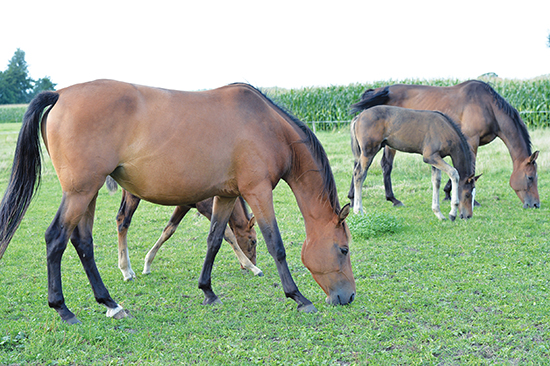
Half-sisters to Hello Sanctos, left by Numero Uno, right, Berlin
Willy bred to Quasimodo on the advice of master breeder, Joris de Brabander. Lieve explains: “Quite a long time ago, the father of Joris came with his stallions and made a display, and we made an agreement. Okay we have three mares, you can pick a stallion you think is suitable for the mare, then when we have the foals we can decide if we want to keep them or sell them.”
“We sold Sanctos when he was two years old.”
Was he special then?
“No-one could guess that he was so special. Even after we sold him, he was sold through and all the people who had him and rode him, could not guess that the horse would be so great. It was only with Scott Brash that there was the magic combination. My father always says, ‘breeding is gambling’.”
“I want to especially mention my mother because she was the brains behind it, she was the commercial one, she would never sell a horse too cheap, she believed in what was born here. You can ask everyone who has tried to buy a horse here, my mother was a tough one, she wanted to have money because she was convinced she was selling good quality horses.”
“I do it because in 2012 my mother developed a tumor, it was so special in that year Sanctos came to Scott, and we saw him in the summer of that year at the Olympic Games, it kept us going. My mother passed away at the end of 2012 but she saw it, we had some photos printed out, to put in the room where she was lying, she could see that her work had amounted to something. That’s why after she passed away, we talked and decided, the mother of Sanctos was here, let’s keep going with all the good mother lines we have, let’s try to breed something special.”
“We have three good mother lines. From the Lipizzaner mare, there have been good horses, she had a very good character, very brave very honest, willing to do the work. From her, Eric van der Vleuten rode a horse called Audi’s Sissi van het Gravenhof, Philippe Rozier had one called Penelope van het Gravenhof and last but not least Kalinka van het Gravenhof was sold as young horse to Canada, there she got another name and competed Nations Cup with Elliott Stone.”
Willy and Nasia van het Gravenhof (dam of Hello Sanctos) / Photo supplied by Lieve Taets
“We had another line from Daphnee de Bornival she produced a Randel Z son, an approved stallion sold to Canada. Then we have the line of Sanctos.”
“From the line of the white mare, we have one by Echo van ‘t Spieveld. My mother was alive then and she said to my son, Joachim – that is one for you.”
“I am riding that horse now,” says Joachim taking up the story, and keeping it going into the next generation. “She is now jumping 1.20m, she is a really nice horse with a really good character, she will always jump, but she is not that careful. For me it is wonderful because I can learn so much from that horse.”
“I have trained her completely by myself. She is so honest.”
Do you see yourself as a jumping rider or a breeder in the future?
“I think both. I really like breeding, I like watching the stallions and assessing them. With the jumping, I like most to work with young horses. I am not so brave to jump 1.60, but I have the ability to teach young horses to a nice level, and then sell them. That gives me more satisfaction…”
“I chose Comme il faut – Cornet Obolensky is great, he is a wonderful stallion, but his semen is difficult, and for that mare to get transfer embryos is difficult, so I went looking for a son of him, and Comme il faut is also from a super mother line – Ratina – and his jumping is wonderful. He just wants to eat the jump, and he is a beautiful stallion. The mare is by Nabab, quite classic, quite strongly built so with Comme il faut the foals should be a little more modern but still have that mentality of just wanting to jump.”
It seems the Taets don’t just breed good horses.
My sincere thanks to all the people who have made this story possible, in particular the crew at sBs…



